Рынок электрических коммерческих автомобилей: текущий анализ и прогноз (2024-2032 гг.)
Акцент на типе транспортного средства (легкий коммерческий автомобиль, средний коммерческий автомобиль и тяжелый коммерческий автомобиль), силовой установке (аккумуляторный электромобиль (BEV), гибридный электромобиль (HEV), подключаемый гибридный электромобиль (PHEV), электромобиль на топливных элементах (FCEV)), емкости аккумулятора (менее 50 кВтч, от 50 до 250 кВтч и более 250 кВтч) и регионе/стране
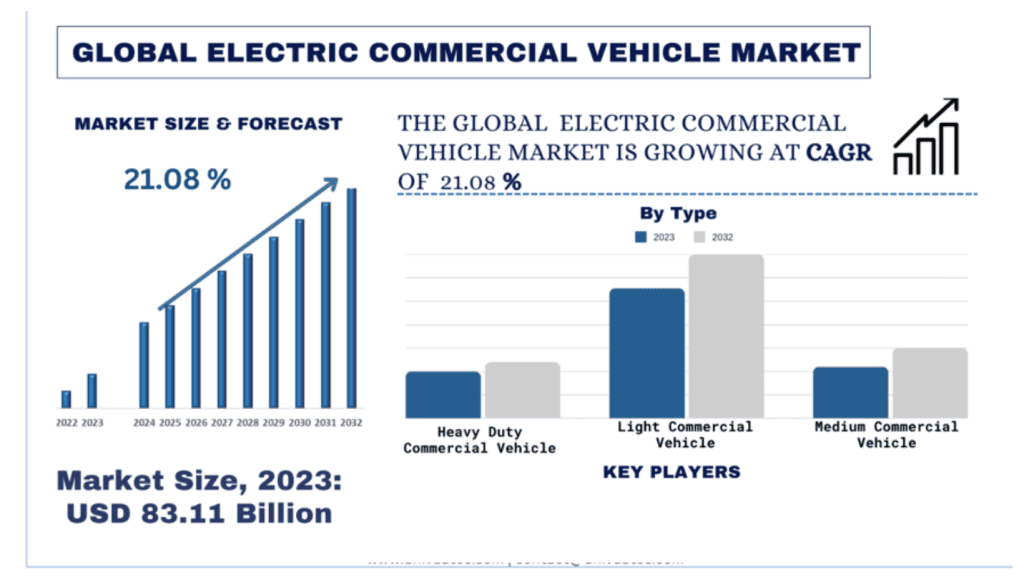
Размер и прогноз рынка электрических коммерческих автомобилей
Объем рынка электрических коммерческих автомобилей оценивался в 83,11 млрд долларов США и, как ожидается, будет расти с высокими среднегодовыми темпами роста (CAGR) около 21,08 % в течение прогнозируемого периода (2024-2032 гг.).
Анализ рынка электрических коммерческих автомобилей
Глобальный рынок электрических коммерческих автомобилей (ECV) переживает подъем, обусловленный строгими нормами выбросов, и растущая осведомленность об изменении климата подталкивают предприятия и правительства к принятию устойчивых транспортных решений. ECV предлагают значительное сокращение выбросов парниковых газов по сравнению с традиционными автомобилями с дизельным или бензиновым двигателем. Кроме того, технология аккумуляторов быстро развивается, предлагая больший запас хода и более быстрое время зарядки. Это делает ECV более жизнеспособным вариантом для коммерческого применения, где эксплуатационная эффективность имеет решающее значение. Многие правительства предлагают субсидии и налоговые льготы для стимулирования внедрения ECV. Эта финансовая поддержка помогает компенсировать более высокую первоначальную стоимость электромобилей по сравнению с традиционными.
Тенденции рынка электрических коммерческих автомобилей
Рынок электрических коммерческих автомобилей (ECV) — это динамичное пространство, претерпевающее быструю трансформацию. Вот разбивка ключевых тенденций, формирующих его будущее. Правительства во всем мире вводят более строгие стандарты выбросов, подталкивая производителей к разработке более экологически чистых автомобилей. Это благоприятствует ECV, которые не производят выбросов из выхлопной трубы. Многие города внедряют зоны с низким уровнем выбросов (LEZs), где традиционные транспортные средства сталкиваются с ограничениями или запретами. Это стимулирует предприятия, работающие в этих районах, к внедрению ECV. Улучшения дальности действия и срока службы аккумуляторов имеют решающее значение для более широкого внедрения ECV. Мы наблюдаем разработки в области литий-ионной аккумуляторной химии и потенциал твердотельных аккумуляторов, предлагающих еще больший запас хода и более быстрое время зарядки. Интеграция технологии автономного вождения с ECV открывает огромный потенциал для оптимизации логистики и операций доставки.
Ожидается, что Азиатско-Тихоокеанский регион будет расти со значительным среднегодовым темпом роста в течение прогнозируемого периода.
Европа стала лидером на мировом рынке электрических коммерческих автомобилей (ECV), чему способствовало стечение факторов, создающих благоприятную почву для их внедрения. Вот более глубокое погружение в то, почему Европа переживает значительный рост в этом секторе. Цели ЕС по сокращению выбросов: Европейский Союз (ЕС) установил агрессивные цели по сокращению выбросов для транспортных средств. Эти правила подталкивают производителей к разработке более экологически чистых альтернатив, что делает ECV убедительным решением. Несколько европейских стран, таких как Норвегия, Нидерланды и Дания, планируют ввести запреты на продажу новых автомобилей с двигателями внутреннего сгорания в ближайшие годы. Это создает сильный стимул для бизнеса переходить на ECV. Субсидии и налоговые льготы: Европейские правительства предлагают различные финансовые стимулы для продвижения внедрения ECV. К ним относятся субсидии на закупочную цену, налоговые льготы на регистрацию и дорожные сборы, а также поддержка развития зарядной инфраструктуры. Многие европейские страны установили амбициозные климатические цели и рассматривают ECV как важный инструмент для их достижения. Это выливается в государственную политику и инициативы по финансированию, которые конкретно поддерживают рынок ECV. В то время как Европа лидирует, эти факторы, влияющие на ее рынок ECV, также обещают более широкое глобальное внедрение.
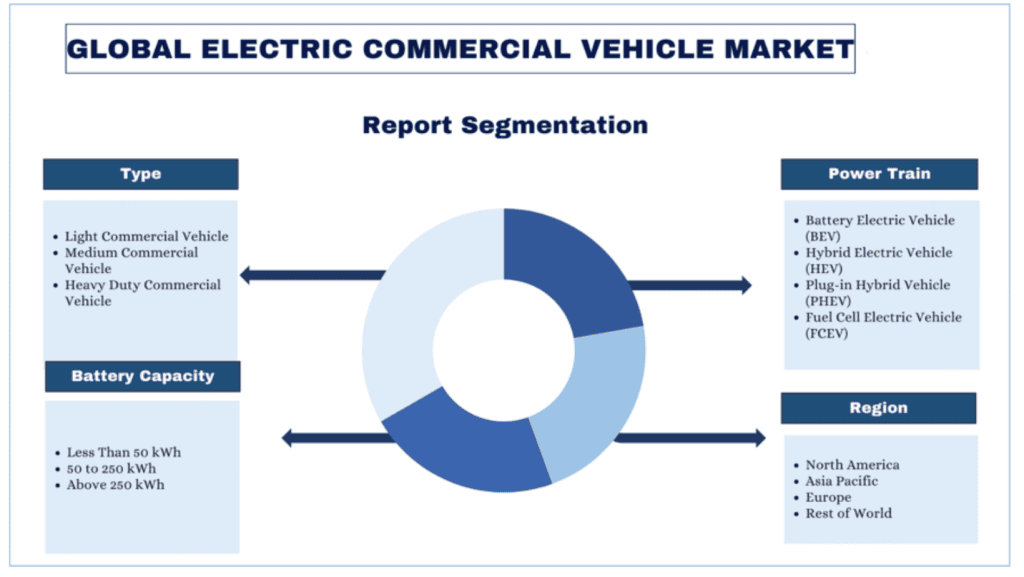
Обзор индустрии электрических коммерческих автомобилей
Рынок электрических коммерческих автомобилей является конкурентным и фрагментированным, с присутствием нескольких глобальных и международных игроков рынка. Ключевые игроки используют различные стратегии роста для расширения своего присутствия на рынке, такие как партнерства, соглашения, сотрудничество, запуск новых продуктов, географическая экспансия, слияния и поглощения. Некоторые из основных игроков, работающих на рынке, - это BYD Company Ltd, AB Volvo, Mercedes-Benz Group AG., TRATON GROUP, Nikola Corporation., Tesla, DAF, Rivian., Yutong Bus Co., Ltd. и SANY Global.
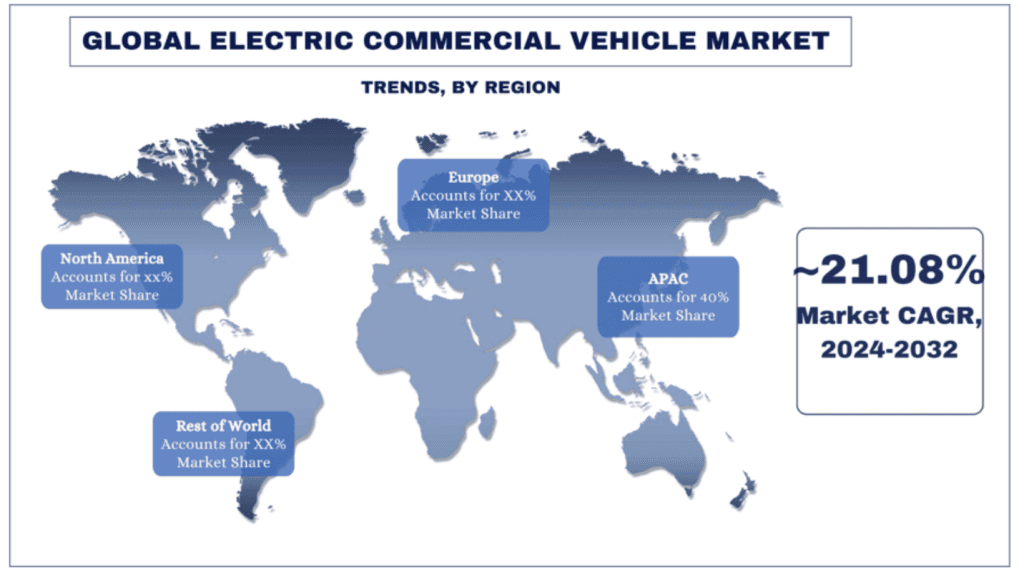
Новости рынка электрических коммерческих автомобилей
2023: Daimler Truck: представила свой полностью электрический eActros LongHaul для магистральных перевозок с целевым запасом хода более 500 километров на одной зарядке (ожидаемый запуск в 2024 году).
Tesla: анонсировала электрический грузовик Semi, столкнувшийся с задержками, но стремящийся к серийному производству в 2024 году.
Volvo Trucks: запустила свою линейку тяжелых электрических грузовиков Volvo FH, FM и FMX Electric в Европе и Северной Америке.
BYD: китайский гигант по производству электромобилей продолжал доминировать на мировом рынке электрических автобусов.
2024: Mercedes-Benz Vans: объявила о партнерстве с правительством Польши для строительства нового производственного завода, полностью посвященного электрическим фургонам.
Volkswagen Group: запустила пилотные программы тестирования своих электрических фургонов в США и Европе.
Rivian: объявила о партнерстве с Amazon для поставки 100 000 электрических фургонов.
Ford: представила свой полностью электрический пикап F-150 Lightning Pro, специально разработанный для коммерческого применения.
Охват отчета о рынке электрических коммерческих автомобилей
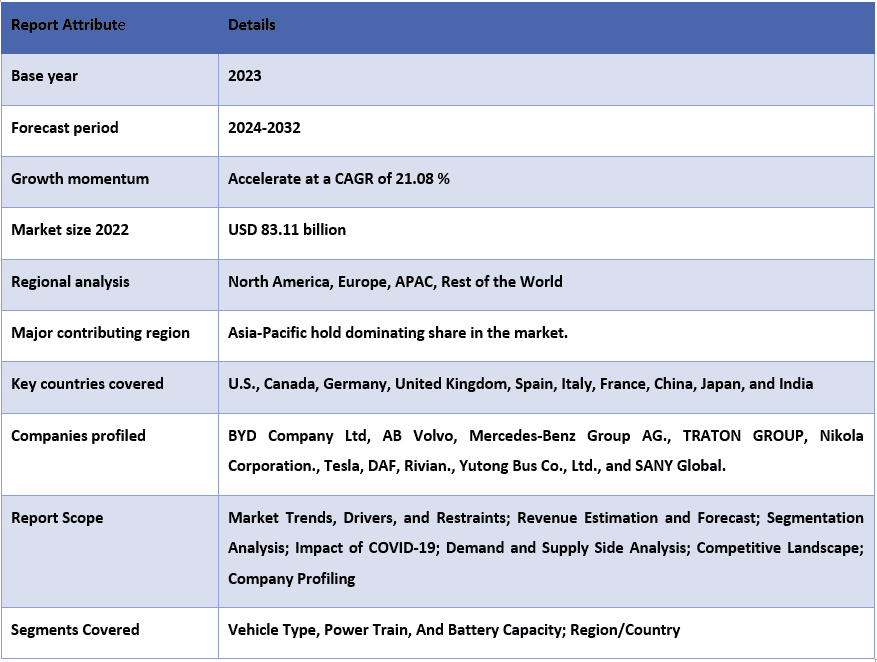
Причины купить этот отчет:
- Исследование включает анализ размера рынка и прогнозирование, подтвержденный проверенными ключевыми экспертами отрасли.
- Отчет представляет собой краткий обзор общей производительности отрасли с первого взгляда.
- Отчет охватывает углубленный анализ видных представителей отрасли с основным упором на ключевые финансовые показатели бизнеса, портфели продуктов, стратегии расширения и последние разработки.
- Подробное изучение драйверов, ограничений, ключевых тенденций и возможностей, преобладающих в отрасли.
- Исследование всесторонне охватывает рынок по различным сегментам.
- Углубленный анализ отрасли на региональном уровне.
Варианты настройки:
Глобальный рынок электрических коммерческих автомобилей может быть дополнительно настроен в соответствии с требованиями или любым другим сегментом рынка. Кроме того, UMI понимает, что у вас могут быть свои собственные бизнес-потребности, поэтому не стесняйтесь обращаться к нам, чтобы получить отчет, который полностью соответствует вашим требованиям.
Содержание
Методология исследования анализа рынка электрического коммерческого транспорта (2024-2032 гг.)
Анализ исторического рынка, оценка текущего рынка и прогнозирование будущего рынка глобального рынка электрического коммерческого транспорта были тремя основными этапами, предпринятыми для создания и анализа внедрения электрического коммерческого транспорта в основных регионах мира. Было проведено исчерпывающее вторичное исследование для сбора исторических данных о рынке и оценки текущего размера рынка. Во-вторых, для подтверждения этих выводов было принято во внимание множество результатов и предположений. Кроме того, были проведены исчерпывающие первичные интервью с отраслевыми экспертами по всей цепочке создания стоимости глобального рынка электрического коммерческого транспорта. После предположения и подтверждения рыночных данных посредством первичных интервью мы использовали подход "сверху вниз/снизу вверх" для прогнозирования полного размера рынка. После этого были приняты методы декомпозиции рынка и триангуляции данных для оценки и анализа размера рынка сегментов и подсегментов соответствующей отрасли. Подробная методология описана ниже:
Анализ исторического размера рынка
Шаг 1: Углубленное изучение вторичных источников:
Было проведено детальное вторичное исследование для получения исторических данных о размере рынка электрического коммерческого транспорта из внутренних источников компании, таких как годовые отчеты и финансовые отчеты, презентации о результатах деятельности, пресс-релизы и т. д., и внешних источников, включая журналы, новости и статьи, правительственные публикации, публикации конкурентов, отраслевые отчеты, сторонние базы данных и другие надежные публикации.
Шаг 2: Сегментация рынка:
После получения исторических данных о размере рынка электрического коммерческого транспорта мы провели детальный вторичный анализ для сбора исторических данных о рынке и доли различных сегментов и подсегментов для основных регионов. Основные сегменты, включенные в отчет, - это тип транспортного средства, силовая установка и емкость аккумулятора. Был проведен дальнейший анализ на уровне стран для оценки общего внедрения моделей тестирования в этом регионе.
Шаг 3: Факторный анализ:
После получения исторических данных о размере рынка различных сегментов и подсегментов мы провели детальный факторный анализ для оценки текущего размера рынка электрического коммерческого транспорта. Кроме того, мы провели факторный анализ, используя зависимые и независимые переменные, такие как тип транспортного средства, силовая установка и емкость аккумулятора рынка электрического коммерческого транспорта. Был проведен тщательный анализ сценариев спроса и предложения с учетом ведущих партнерств, слияний и поглощений, расширения бизнеса и запуска продуктов в секторе рынка электрического коммерческого транспорта по всему миру.
Оценка текущего размера рынка и прогноз
Определение текущего размера рынка: На основе практически применимых данных, полученных на основе вышеуказанных 3 этапов, мы определили текущий размер рынка, ключевых игроков на глобальном рынке электрического коммерческого транспорта и доли рынка сегментов. Все необходимые процентные доли разделения и разбивки рынка были определены с использованием вышеупомянутого вторичного подхода и были проверены посредством первичных интервью.
Оценка и прогнозирование: Для оценки и прогнозирования рынка веса были присвоены различным факторам, включая движущие силы и тенденции, ограничения и возможности, доступные для заинтересованных сторон. После анализа этих факторов были применены соответствующие методы прогнозирования, то есть подход "сверху вниз/снизу вверх", чтобы получить прогноз рынка на 2030 год для различных сегментов и подсегментов на основных рынках по всему миру. Методология исследования, принятая для оценки размера рынка, включает в себя:
- Размер рынка отрасли с точки зрения дохода (в долларах США) и темпы внедрения электрического коммерческого транспорта на основных рынках внутри страны
- Все процентные доли, разделения и разбивки сегментов и подсегментов рынка
- Ключевые игроки на глобальном рынке электрического коммерческого транспорта с точки зрения предлагаемых продуктов. Кроме того, стратегии роста, принятые этими игроками для конкуренции на быстрорастущем рынке.
Подтверждение размера рынка и доли
Первичное исследование: Были проведены углубленные интервью с ключевыми лидерами мнений (KOL), включая руководителей высшего звена (CXO/VPs, руководители отдела продаж, руководители отдела маркетинга, руководители операционного отдела, региональные руководители, руководители стран и т. д.) в основных регионах. Затем были обобщены результаты первичного исследования и проведен статистический анализ для доказательства заявленной гипотезы. Данные, полученные в результате первичного исследования, были объединены с вторичными данными, что позволило превратить информацию в практически применимые данные.
Разбивка участников первичного исследования по разным регионам
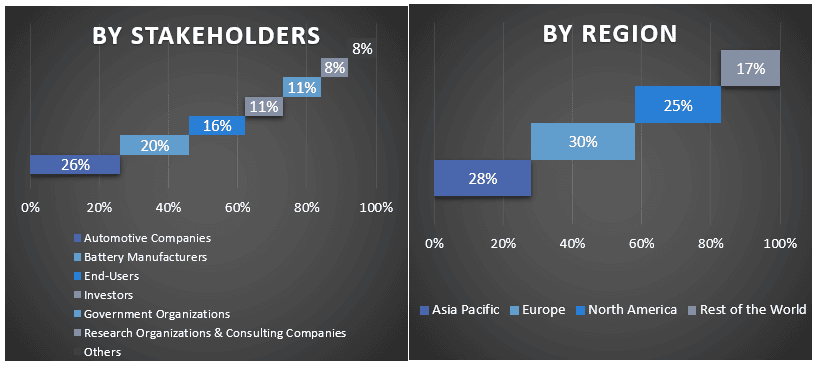
Инженерия рынка
Метод триангуляции данных был использован для завершения общей оценки рынка и получения точных статистических данных для каждого сегмента и подсегмента глобального рынка электрического коммерческого транспорта. Данные были разделены на несколько сегментов и подсегментов после изучения различных параметров и тенденций в областях типа, технологии, компонента и конечного пользователя на глобальном рынке электрического коммерческого транспорта.
Основная цель исследования глобального рынка электрического коммерческого транспорта
В исследовании были точно определены текущие и будущие тенденции рынка глобального рынка электрического коммерческого транспорта. Инвесторы могут получить стратегическую информацию, чтобы основывать свое усмотрение для инвестиций на качественном и количественном анализе, выполненном в исследовании. Текущие и будущие тенденции рынка определили общую привлекательность рынка на региональном уровне, предоставляя промышленному участнику платформу для эксплуатации неиспользованного рынка, чтобы воспользоваться преимуществом первопроходца. Другие количественные цели исследований включают:
- Анализ текущего и прогнозируемого размера рынка электрического коммерческого транспорта с точки зрения стоимости (в долларах США). Кроме того, проанализируйте текущий и прогнозируемый размер рынка различных сегментов и подсегментов.
- Сегменты исследования включают области типа транспортного средства, силовой установки и емкости аккумулятора.
- Определение и анализ нормативно-правовой базы для электрического коммерческого транспорта
- Анализ цепочки создания стоимости с участием различных посредников, а также анализ поведения клиентов и конкурентов в отрасли.
- Анализ текущего и прогнозируемого размера рынка электрического коммерческого транспорта для основного региона.
- Основные страны регионов, изученные в отчете, включают Азиатско-Тихоокеанский регион, Европу, Северную Америку и остальной мир
- Профили компаний рынка электрического коммерческого транспорта и стратегии роста, принятые участниками рынка для поддержания себя на быстрорастущем рынке.
- Углубленный анализ отрасли на региональном уровне
Часто задаваемые вопросы Часто задаваемые вопросы
В1: Каков текущий размер рынка и потенциал роста рынка электрических коммерческих автомобилей?
Q2: Каковы движущие факторы роста рынка электрических коммерческих автомобилей?
Q3: Какой сегмент имеет наибольшую долю на рынке электрических коммерческих автомобилей по типу?
Q4: Каковы новые технологии и тенденции на рынке электрических коммерческих автомобилей?
Q5: Какой регион будет доминировать на рынке электрических коммерческих автомобилей?
Связанные Отчеты
Клиенты, купившие этот товар, также купили










